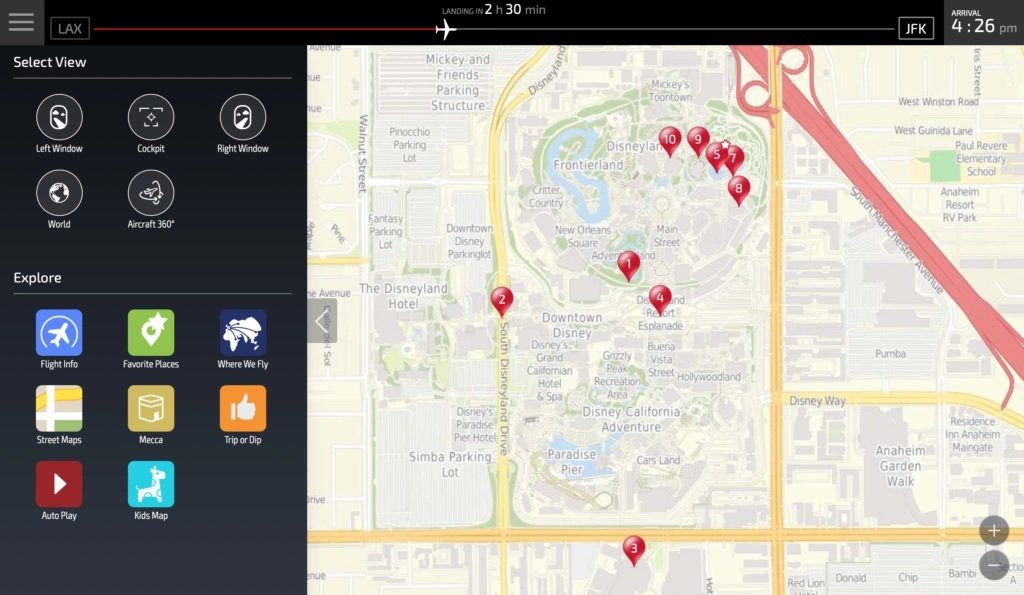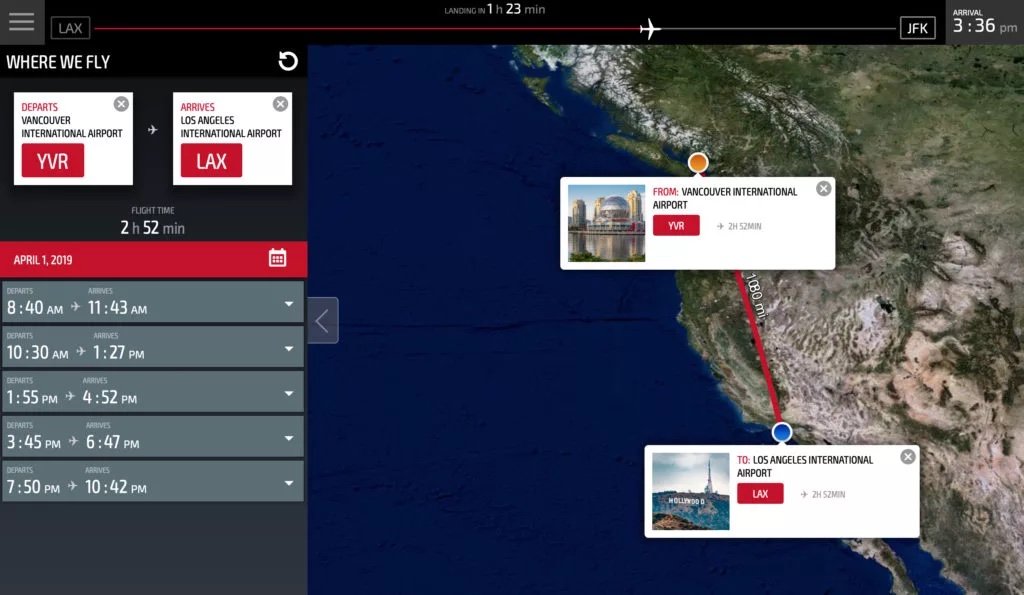FlightPath3D Crunches Big Data To Improve The Moving Map
Explore points of interest at a destination, down to the individual rides in a theme park. The new Favorite Places app from FlightPath3d processes a huge amount of data to determine what to share with travelers en route.
Looking to maximize passenger engagement with an inflight entertainment system? The moving map interface is the best place to start and FlightPath3D released two new options this week to keep travelers entertained while also potentially increasing airline revenue.
The company’s moving map interface is already flying with more than 50 airlines and delivers airline-specific data options for points of interest. The latest iteration adds a flight planning module called “Where We Fly” and a significant expansion and upgrade for points of interest called “Favorite Places” to the product suite.
What should we see?
Helping travelers to explore their destination before they arrive has long been a key component of the FlightPath3D proposition. The Points of Interest database allows for passengers to explore highlights and even potentially buy tickets or book reservations. The upgraded version released this week, in advance of Aircraft Interiors Expo 2019, leverages massive amounts of data to help select what points to share and increase the rich media content available in the system.
A proprietary, patent pending algorithm helps the company collect data on more than 400,000 attractions around the globe. FlightPath3D organizes details from traveler reviews, social media platforms and other sources to determine what’s worth seeing. As passengers zoom around on the maps they see a varying collection of potential destinations to explore.
We’ve aggregated and collected an enormous data set of places of interest that have a location reference so we can geo-code them. We then socially organize the data using a proprietary algorithm that has analyzed billions of traveler reviews, photos, visits and other social records as it pertains to each place of interest (castle, museum, theme park, etc.) to rank and create a score for over 400,000+ attractions worldwide. This means passengers can check out what’s trending in any neighborhood because we dynamically change POI’s based on any zoom level in the map. Passengers can literally see what rides are trending in a theme park. – VP, Marketing Jon Norris
Individual points can be flagged as favorites by passengers, eventually compiling a list of things to see and do once the plane lands. As VP-Marketing Jon Norris explains, “The goal is to allows passengers to plan what to do when they land or plan their next trip. It’s an innovative way to inspire others to seek out new destinations or visit a landmark they never thought they would.”
In addition to helping travelers discover more opportunities to explore there is a monetization option available. FlightPath3D has been working for the past several years on enabling that commercial transaction infrastructure. Jackson spoke to it in late 2017 around booking car transfers and hotel rooms. The potential sales opportunities continue to expand.
Getting the favorites list off the FlightPath3D system and in to a portable format for passengers remains a challenge, but there are options available. Norris suggests that some implementations, such as via integration into an airline app, could allow for full offline access. Less advanced models include taking a screen shot of the list or a photo of the in-seat screen after populating the Favorites List. Monetization depends on connectivity and the more feature-rich experience. But even the limited version delivers a more entertaining experience to passengers than traditional maps.
Selling seats en route
Selling third party services is a high margin business but also means handing off your customer to a third party. For airlines that want to keep travelers in their seats on board the Where We Fly option presents a unique sales opportunity. The system loads an airline’s flight schedule into the mapping system and lets passengers search for future flights while on board. Selling seats is the obvious proposition, but FlightPath3D President Duncan Jackson is more focused on the data behind the searches. “The data gathered from passengers’ searches can help an airline plan routes, rank destinations, and find out what’s important to passengers when booking a trip.”
The visual interface is a new approach to such flight searches and offers the opportunity for experimentation and disruption. Just how far airlines are willing to push that opportunity remains to be seen. Ditto for travelers’ desire to spend their time in flight searching for more trips.
Search for flights, including real schedule data, as part of the new Where We Fly module available to airlines from FlightPath3D
The Where We Fly interface can operate completely offline, with schedule updates loaded in on the ground similar to other entertainment content. For aircraft with inflight connectivity systems the options expand, allowing for real-time fare data and seat maps to be part of the data displayed to passengers.
Completing the connection
The new use cases, like all of the FlightPath3D products, can operate completely offline. But the passenger experience benefits significantly when connectivity enters the equation. The systems are efficient, able to run on lightweight connections, the same sort of lightweight service AirFi will use with Atlantic Airways for limited payment processing and messaging services. With a tiny bit of bandwidth FlightPath3D can take restaurant reviews and turn them into a real-time booking option. Even without that connection the company can store requests and process them once on the ground. Duncan has previously demonstrated that technology with the Uber ride-hailing platform.
If the airlines can build out a solution that generates new revenue through these channels the investment in the connection could prove to be smart spending. But that remains an unproven market. FlightPath3D hopes the improved user interaction with the content will enable more purchases. And the company processes massive amounts of data to bring those transactions to life.
This article was originally posted on PAXEX.AERO here.


